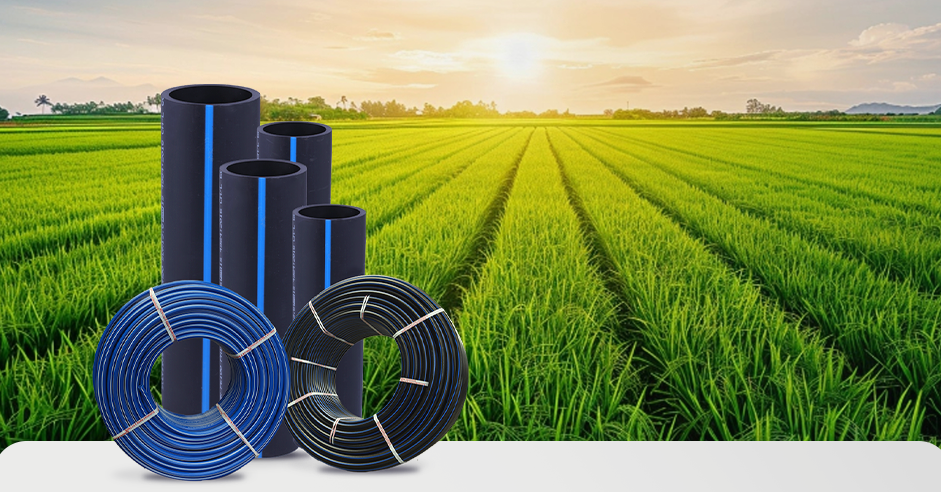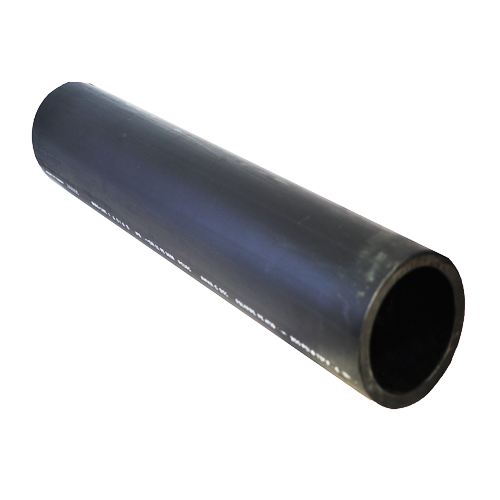Why Partnering with Pipe Supplier American Plastics Midland Ensures Timely Supply
Explore the Manufacturing Refine Behind High-Quality HDPE Pipeline and Its Applications
The manufacturing process of top quality HDPE pipes is intricate and systematic. It starts with the option of raw products that boost performance. Following this, ethylene undergoes polymerization to form resin, which is after that shaped with extrusion. Quality control is extremely important, making sure that the last item satisfies rigorous standards. Nevertheless, the trip of HDPE pipes does not finish with manufacturing. Their applications across various sectors expose a wider significance worth analyzing.
Comprehending HDPE: Residences and Advantages

High-density polyethylene (HDPE) is a versatile polycarbonate recognized for its longevity and resistance to different ecological variables. This material displays excellent tensile toughness, making it ideal for demanding applications. Its low-density framework adds to a lightweight product, helping with ease of managing and setup. HDPE likewise showcases impressive resistance to chemicals, which minimizes degradation when exposed to rough materials.
The product's low dampness absorption additionally enhances its durability, making it ideal for use in pipes and tank. Furthermore, HDPE is resistant to ultraviolet (UV) radiation, guaranteeing that products preserve their honesty even when subjected to sunlight. Its flexibility enables for the creation of intricate forms without jeopardizing strength. The environment-friendly nature of HDPE, usually stemmed from recycled products, includes to its charm, promoting sustainable practices in production. Overall, these properties and benefits make HDPE a recommended choice for different commercial and consumer applications.
Resources Option for HDPE Manufacturing
The selection of basic materials for HDPE manufacturing is vital to verify the last product satisfies the preferred specifications and high quality standards. High-density polyethylene (HDPE) is mostly created from polymerized ethylene, obtained from fossil gas such as gas or crude oil. The quality of these feedstocks significantly influences the mechanical and thermal residential properties of the final HDPE.
Additives additionally play a significant duty in enhancing HDPE's performance, including anti-oxidants, UV stabilizers, and colorants, which enhance longevity and resistance to environmental aspects. The selection process need to think about not only the chemical structure of the raw products however likewise their handling qualities to guarantee efficient manufacturing.
The sourcing of raw materials need to prioritize sustainability and conformity with environmental policies, as accountable techniques are imperative in today's market. Ultimately, mindful basic material option lays the structure for producing top quality HDPE pipes suitable for varied applications.
The Extrusion Process: Shaping HDPE Pipe
The extrusion process plays a crucial role fit HDPE pipes, beginning with meticulous material preparation methods that assure suitable flow and consistency. Equally important is the layout of the die, which straight influences the final dimensions and surface quality of the pipeline. Together, these factors contribute significantly to the efficiency and quality of HDPE pipe manufacturing.
Product Preparation Techniques
Reliable manufacturing of HDPE pipes begins with careful material preparation methods, especially the extrusion procedure. During this stage, high-density polyethylene material is very first dried out to get rid of dampness, making sure perfect circulation qualities. The resin is then fed right into the extruder, where it undergoes home heating and melting, changing into a thick state. This home heating procedure is carefully controlled to preserve the material's stability and performance. The liquified HDPE is forced via a die, shaping it into a continual pipeline type. Appropriate temperature monitoring throughout extrusion is essential, as it straight impacts the product's buildings and the last product quality. When shaped, the HDPE pipeline is cooled and reduced to specified lengths, ready for succeeding processing and applications.
Die Style Significance
Precision in die style plays a necessary duty in the extrusion procedure of HDPE pipelines. The die acts as the last shaping tool, straight affecting the pipeline's measurements, wall surface density, and surface area coating. A properly designed die guarantees consistent product circulation, lowering issues such as irregularities and weak points. The geometry of the die must be maximized to suit the details homes of HDPE, including its viscosity and thermal behavior throughout extrusion. In addition, the cooling rate of the product as it passes with the die can markedly affect the pipe's structural integrity. Spending in innovative die innovation is essential for manufacturers intending to produce high-grade HDPE pipes that meet industry requirements and consumer assumptions.
Top Quality Control Procedures in HDPE Production
Different variables influence the top quality of HDPE pipe manufacturing, efficient high quality control actions are crucial to ensure consistency and reliability in the final item (Pipe Supplier American Plastics Midland). Key top quality control techniques include strenuous material examination, verifying that the raw polyethylene meets recognized requirements for pureness and density. During the extrusion process, specifications such as temperature level, pressure, and cooling time are very closely kept an eye on to preserve dimensional precision and structural honesty
Furthermore, post-production screening is essential; manufacturers typically conduct hydrostatic tests to analyze the pipe's toughness and resistance to pressure. Visual inspections for surface area flaws better boost quality control. Certification from pertinent criteria companies, like ASTM or ISO, supplies an added layer of trustworthiness. By executing these detailed quality assurance steps, suppliers can reduce defects, boost efficiency, and make sure that the find more information HDPE pipes meet the specific demands of various applications, ultimately causing client fulfillment and rely on the item.
Applications of HDPE Pipeline Across Industries
HDPE pipes are made use of throughout different fields due to their longevity and versatility. In water distribution systems, they assure efficient delivery, while in wastewater management, they give dependable options for waste transportation. Furthermore, farming watering networks take advantage of HDPE's resistance to corrosion and versatility, making it an ideal option for modern farming practices.

Water Distribution Solutions
A significant number of markets count on high-density polyethylene (HDPE) pipes for effective water distribution systems. Understood for their sturdiness and resistance to corrosion, HDPE pipelines are commonly used in local water supply networks, farming watering, and industrial applications. Their lightweight nature assists in easy handling and installation, minimizing labor prices and time. Additionally, HDPE pipelines can accommodate various pressure degrees, making them appropriate for both low and high-pressure systems. Pipe Manufacturing Midland TX. The adaptability of the product enables smooth assimilation into existing facilities, minimizing the requirement for comprehensive excavation. HDPE's resistance to chemical seeping assurances that the water supplied remains risk-free and tidy, making it an optimal option for maintaining the top quality of potable water across different industries.
Wastewater Monitoring Solutions
Effective water distribution systems additionally lead the way for ingenious wastewater management solutions, where high-density polyethylene (HDPE) pipelines play a considerable duty. Popular for their resilience and resistance to corrosion, HDPE pipes are ideal for moving wastewater in different setups. Their flexibility enables very easy setup in complex atmospheres, reducing the need for considerable excavation. Additionally, HDPE's smooth interior surface area decreases rubbing, boosting circulation prices and effectiveness. These pipelines are additionally immune to chemical leaching, ensuring that impurities do not jeopardize the surrounding atmosphere. Industries, districts, and treatment facilities progressively depend on HDPE pipes for their dependability and long life, making them a favored option for contemporary wastewater monitoring systems. This flexibility underscores the critical significance of HDPE pipes across countless applications.
Agricultural Irrigation Networks
Agricultural irrigation networks benefit significantly from making use of high-density polyethylene (HDPE) pipes, which supply effective and trusted water distribution to crops. HDPE pipelines are lightweight, making them easy to transfer and install, while their adaptability enables numerous arrangements in varied terrains. These pipes show superb resistance to deterioration, chemicals, and UV radiation, guaranteeing durability in harsh farming atmospheres. Furthermore, their smooth indoor surface decreases rubbing loss, optimizing water flow and minimizing energy prices connected with pumping. The durability of HDPE pipelines, usually going beyond 50 years, adds to reduce maintenance and replacement costs. Farmers increasingly depend on HDPE pipes to improve irrigation efficiency and advertise sustainable agricultural practices, inevitably leading to improved plant yields and resource conservation.

Future Fads in HDPE Pipe Innovation
As the need for lasting and effective infrastructure grows, advancements in HDPE pipeline modern technology are positioned to transform numerous markets. Emerging patterns include the assimilation of clever innovations, such as sensing units and IoT abilities, which promote real-time surveillance of pipe problems, reducing maintenance costs and protecting against leaks. In addition, the development of sophisticated production strategies, such as 3D printing, is making it possible for the production of complex, customized pipeline styles that accommodate details task requirements.
The emphasis on recycling and round economic climate techniques is driving the advancement of HDPE pipelines made from recycled products, boosting sustainability. Boosted jointing techniques, such as electro-fusion and mechanical fittings, are likewise boosting installation performance and reliability. Finally, the growing emphasis on environmental laws is pushing producers to embrace greener production processes, guaranteeing that HDPE pipes not only satisfy market useful site standards however likewise promote a more sustainable future for facilities growth.
Frequently Asked Inquiries
Just How Does HDPE Compare to Other Plastic Products?
HDPE surpasses many various other plastic products relating to longevity, chemical resistance, and adaptability. Its reduced density and high tensile stamina make it suitable for numerous applications, typically going beyond alternatives in both efficiency and long life.
What Are the Ecological Effects of HDPE Production?
The ecological effects of HDPE manufacturing include greenhouse gas emissions, power consumption, and possible contamination from manufacturing procedures. Additionally, inappropriate disposal can result in dirt and water contamination, increasing concerns concerning lasting ecological effects.
Can HDPE Pipes Be Recycled?
Yes, HDPE pipes can be reused. Numerous facilities approve made use of HDPE for processing, changing it into brand-new products. This recycling adds to sustainability efforts, minimizing plastic waste while preserving sources and power in the manufacturing cycle.
What Is the Life-span of HDPE Water Lines?
_-_Post_di_Facebook_-_Dimensioni_personalizzate_(1)_60cafdf20856f.png)
Just How Do Temperature Level Variations Influence HDPE Pipe Performance?
Temperature level variations greatly influence HDPE pipeline performance, impacting flexibility and toughness. High temperatures can bring about softening, while low temperature levels might cause brittleness, inevitably influencing the pipe's resilience and suitability ductile iron pipe fittings for different applications in varied atmospheres.